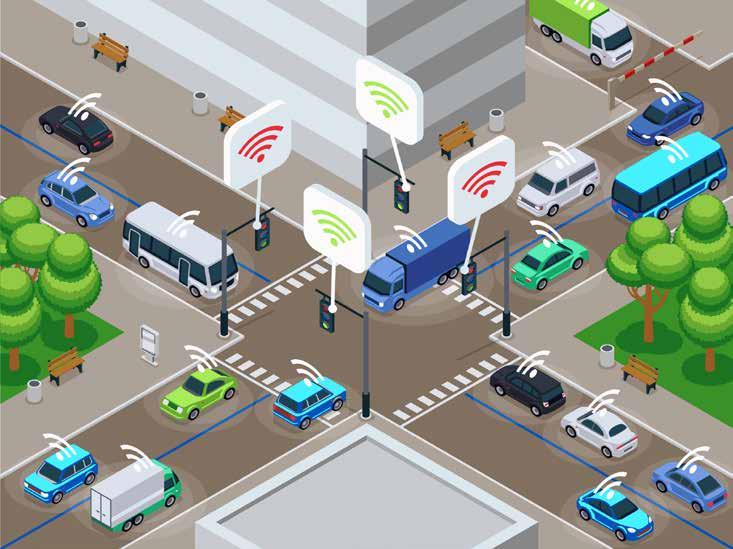
7 minute read
Potential implications for the Indian automotive ecosystem
It is apparent that stakeholders across the automotive ecosystem need to prepare and plan to rebound in a phased manner, while bracing for a long-term impact. While they may respond by taking some actions immediately, they must also consider preparing in advance to launch initiatives just after lockdown ends, and recover by capturing maximum value. In addition to these short-term actions, players also need to respond to permanent disruptions that this pandemic may have brought about (e.g. consumer behaviour, dependence on fund capex, relieve interest burden for few weeks)
global networks), and prepare to reinvent their businesses with long-term interventions (Figure 4).
Advertisement
We discuss some themes around which players need to act to enable themselves to be ‘battle-ready’ for their quest to revive the industry and their respective businesses (Figure 5). These themes are relevant to the prolonged U-shaped recovery that be expected to do whatever within their means to help raise
the auto industry is likely to undergo.
Respond
Engage with customers and the dealer network: Reduced engagement due to lockdown could affect both customer loyalty and the OEM-dealer connect
Help dealership teams upskill through refresher virtual trainings, online certifications and gamified solutions Share relevant do-it-yourself videos on social media to engage with customers
Manage the liquidity crunch in the system: Crunch of working capital due to tepid sales is likely to cripple the smooth functioning of the network • Provide financial support to dealers and suppliers (e.g., provide longer credit period, expedite incentives disbursal, • Introduce cost-cutting measures for non-essential activities/suspend discretionary spends to maintain liquidity
Actively contribute to fighting the pandemic: OEMs will
Figure 5. Potential actions for auto companies3
awareness, provide infrastructure • Side-pocket existing production lines into producing products for healthcare (e.g., sanitizers, personal protective equipment)
Respond
Engage with customers and the dealer network
Manage the liquidity crunch in the system
Actively contribute to fighting the pandemic
Plan well for the post-COVID-19 situation Plan for spike in demand of personal mobility solutions Assess and derisk supply chain dependencies
Re-assess upcoming launches and financing offerings Prepare for an omnichannel sales experience
Respond
Adopt hygiene-centric process and design changes
Capture opportunity to consolidate opportunity Prioritize focus on employee safety and care
Explore alternate revenue options
Reinvent
Plan for shifting mobility preferences of the consumer
Adopt digitalization of consumer touchpoints
Explore offerings around hyper-local delivery model
Redesign manufacturing architecture and supply chain processes
Take initiative to support the affected – e.g., support for all unorganized/ contract workers in the automotive ecosystem
Plan well for the post-COVID-19 situation: Opportunity for players to rethink their way ahead and develop appropriate strategies to navigate the post-crisis situation • Plan to efficiently manage the warranty and dealer claims, which are expected to surge, once lockdown ends • Design trigger-based contingency plans including, and in alignment with the entire network to manage working capital needs
Recover Plan for spike in demand of personal mobility solutions
(vis-à-vis shared solutions): Increased aversion to use shared mobility and public transport may result in a spike in demand for 2-wheelers, entry-level 4-wheelers and pre-owned vehicles immediately after lockdown • Increase focus on “Push” (targeted marketing) to identify prospects rather than relying on traditional “Pull” sources • Design special financing schemes for purchase of vehicles to help customers tide over liquidity crunch
Assess and de-risk supply chain dependencies: High dependency on global auto parts (esp. from China) led to bottlenecks in the supply chain long before the pandemic actually hit India • Plan for short-term demand skew for spare parts; undertake risk assessment of supply chain (suppliers, logistics etc.) • Use analytics to better monitor the supply-demand gap and design short-term response strategies accordingly
Re-assess upcoming launches and financing offerings:
Reduced discretionary spends may push customers to shift to lower-priced segments and variants • Re-assess launch timelines to prioritize products in the lower-price segments to avoid loss of market share • Redesign loyalty programs to demonstrate and retain lifetime value, and overcome the drop in premium purchases
Prepare for an omnichannel sales experience: Even after the lockdown, customers may not want to visit crowded dealerships or interact with the sales staff in person • Explore the concept of virtual sales consultants, and
remote demonstration of vehicles
• Explore the feasibility, capabilities and partnerships required in setting up an integrated online-offline sales
channel
Adopt hygiene-centric process and design changes: The consumer expectation of hygiene, sanitization standards are expected to be more than the current standards maintained by dealers • Include sanitization/fumigation as part of workshop services, test-drive, etc. • Identify innovative solutions to design “No-Contact”
customer journeys and transactions
Prioritize focus on employee safety and care: Healthy, engaged and committed employees are likely to be the most essential resource for any player looking to stage a swift recovery • Redesign safety norms in offices and plants to ensure robust medical security systems and adequate health training for all • Deploy flexible employment systems to ensure a healthy working environment – both medically and mentally
Capture opportunity to consolidate operations: High financial strain on smaller players to operate in low-sales period may force them to close/ sell the business • Evaluate synergies and look at potential alliances/ partnerships/acquisitions • Explore new sources of funding such as private equity for highly stressed dealers and service providers
Explore alternate revenue options: Financial pressures due to loss of business and high fixed costs will require new sources of income to recover the losses incurred • Focus on allied product and services like accessories, value added services in workshop, concierge services, etc. • Re-prioritize existing strategic projects and advance their timelines
Reinvent Plan for shifting mobility preferences of the consumer:
Long-term impact on the growing trends for premiumisation, shared mobility, OEM-fleet partnerships; growing preference for low-touch sales and service experiences, new ownership models that are cash-flow friendly • Review current alliances with cab service providers; focus on new alliances that are expected to gain importance in future such as leased vehicles, corporate tie-ups etc.
Adopt digitalisation of consumer touchpoints to
supplement physical sales: The trend of e-commerce platforms for end-to-end online car purchase is likely to find more acceptance among Indian customers, given higher convenience • Set up partnerships with dealerships, financial service and e-commerce players to design a completely digitalised
customer journey for sales and service; helps decongests physical outlets and allows seamless delivery in areas with low dealership penetration
Explore offerings around hyper-local delivery model:
Increased preference of customers to avoid crowded marketplaces, and prefer no-contact transactions • Align product and customer strategies (e.g. e-bikes for last mile delivery) with the upcoming trends in home delivery • Offer alternate asset ownership models to e-commerce players to reduce the financial burden of high upfront capex
Redesign manufacturing architecture and supply chain
processes: The financial impact of a high fixed-cost model and an import-reliant supply chain has been severely felt by all players • Accelerate the indigenisation of auto components to increase self-sufficiency and minimize risk of supply chain breakdowns • Adopt new business models that shift costs from fixed to variable nature, thereby reducing the breakeven volume • Invest in developing early warning systems/ downturn planning to be able to respond faster in similar future scenarios – agility-driven forecasting
The themes and the illustrative responses mentioned are expected to help auto companies prepare for an expected U-shaped recovery. It is essential to note that this expectation is built on the prevailing condition of the auto industry, and the understanding of the pandemic’s likely spread, the time it takes for containment, and the impact of these events specifically on the auto industry. However, the behaviour of the virus in reality (development of more robust strains vs. development of a vaccine) and the time it takes to contain the spread (2 quarters vs. 4+ quarters) are factors that are difficult to predict with certainty.
It is therefore likely, that the auto sector may head towards an even more prolonged W-shaped recovery instead, wherein a second bout of the pandemic follows the initial remission. Companies must look to identify the onset of such a scenario by tracking and observing certain indicators, so that they are well prepared to respond to the second wave and minimize both, financial losses and the ensuing structural damage to the value chain.
Some of the indicators that may point towards such a possibility are • Reversal in the decreasing trend or a continuous increase in the number of infected cases • Increase in number of infection ‘hotspots’ • Reinforcement/ continuation of lockdown norms, especially in large cities, etc. • Reports of recurrent waves in other economies • Delay in the development of a vaccine • Discovery of alternate strains of the virus
Persistence of these indicators can be a clear sign for auto companies to prepare themselves. While the initiatives discussed across respond, recover and reinvent for the U-shaped recovery remain valid even in this scenario, companies should prioritize to secure their supply chains and develop trigger-based micro work-plans in partnership with the network to ensure adequate working capital to weather the next storm.





